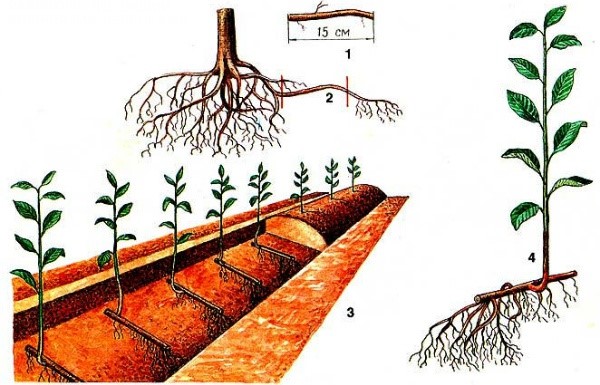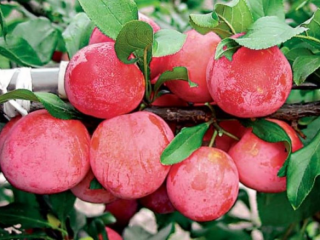Content
You can expand the number of fruit plants in your garden by purchasing ready-made seedlings. But this is an expensive pleasure and not for everyone’s budget. The most affordable option is to propagate plum trees yourself. The easiest way to propagate it is by root shoots. Although there are other, no less effective methods.
Plum propagation
In the process of cultivating fruit crops, several effective methods for propagating plums have been developed. The plant is quite pliable and takes root easily, producing multiple shoots. It should be disposed of in a timely manner so as not to interfere with the full development of the plantings. The article will tell you how to do this correctly and profitably.
Of all the plum propagation methods, vegetative ones are the most popular:
- vaccination;
- cuttings;
- layering;
- germination of seeds;
- root shoots.
The first two types of plum propagation are artificial, the last three are natural.
Plum propagation by layering
When propagating plums by air layering, you can completely preserve the original varietal characteristics. To do this, it is enough to select developed shoots with several living buds on the surface. Then you need to root the plum branch next to the mother bush.
The favorable period for the procedure is spring, and in the fall you can separate and replant in its place. All this time, you should create comfortable conditions for rooting of the cuttings.
Propagation of plums by cuttings
This method of plum propagation has become popular among amateur gardeners, although previously it was used only in industrial production. Its advantage is the high survival rate of plantings and the preservation of valuable varietal qualities. The result depends on a number of factors:
- varieties;
- equipment used;
- condition of planting material and mother plant;
- fertilizers;
- timing of cuttings.
It is recommended to root plum cuttings in the spring.
Propagation by green cuttings
Suitable for dark varieties. A lignified shoot is cut from the mother bush and divided into several parts of 20–25 cm. Each should have 2–3 leaves. After 12–13 hours of standing in a special solution (growth stimulator), they are planted in the ground.
Cover with film, place in a warm place and moisten regularly. After 14–20 days, young plum roots appear.
Plum propagation by shoots
Propagation of plums by root shoots is a favorite method among gardeners due to its simplicity and effectiveness. Suitable for varieties that have a fairly developed root system. They tend to produce offspring in large numbers, with which you can further experiment.
With proper work and proper care, the plum tree will begin to bear fruit almost next year, in a maximum of 2 years.
Reproduction by bone
Another option for propagating plum crops, but not very popular. It will not be possible to preserve the original qualities of the mother plant.
The seeds are first kept in the cold for six months (from autumn to spring), wrapped in damp gauze. After which they are planted in a regular flower pot. Care for the germinated material as for any indoor plant:
- water regularly;
- fertilize;
- carry out preventive treatment against pests.
In the fall, when the shoot is sufficiently elongated, it is transplanted to a garden plot. But it first requires growing in a greenhouse or in a garden bed, under a film. And in the next season, if the plant successfully survived the winter, it is moved to a permanent place of residence.
Plum grafting
To preserve the varietal properties of the plant, this method is the most successful. A scion grown from seeds is grafted onto the rootstock (base). They cut off the bud along with the bark, make a deep transverse incision and insert a scion split into it. The structure is fixed with polyethylene.
Water generously to activate juice flow. After 2–3 weeks, remove the film.
How to propagate a plum tree by shoots
Propagating plums using bark shoots is easier and faster than other methods. Every year the crop produces many shoots, and it is important to constantly remove them so as not to weaken the development of the plant.
Is it possible to grow a plum from shoots?
Plum shoots retain varietal qualities if taken from own root crops - not grafted. Not all varieties are suitable for this. The most acceptable hybrids:
- Hungarian Moscow;
- Tula black;
- Local yellow;
- Red early ripening.
Otherwise, the processes will differ in appearance from the source.
You can plant shoots from healthy plum trees with high productivity. It is recommended to take offspring located at a distance from the mother bush.
Will a plum grown from shoots bear fruit?
Despite all the advantages of propagation by root shoots, even outwardly strong seedlings are less durable and productive than those propagated using other technology. Copper trees bear fruit in different ways.
How to plant plum trees
Most often, the shoots are transplanted to a separate area in the fall, in September - early October. A spring transplant is also possible, before sap flow begins (until the buds open).
Plantings 2–3 years old are chosen as the source for seedlings. They must be healthy, tall, abundantly fruiting and with a developed root system. Such specimens usually grow where there is a lot of light and not far from the mother trees.
Sequence of steps for propagation by shoots:
- Carefully dig out the main root, which lies in a horizontal plane and away from the trunk. A part is cut off.
- If the root is deprived of shoots, then it is grown separately in a greenhouse for some time. Just before this, they are soaked in a solution of “Kornevin” (growth stimulant). This happens when a seedling grows close to the mother tree.
- If there is enough growth, then make holes nearby, add fertilizer there and plant root shoots.
- The soil is thoroughly compacted and watered abundantly.
- Next year, with the first warmth of spring, young seedlings can be transplanted to a permanent place of residence.
It is possible to improve the condition of the roots with the help of advance preparation. In the fall, the root ball of an adult plant is cut along the perimeter using a shovel. In the spring, the plum shoots are dug up and separated.
A similar procedure can be carried out in early spring. Throughout the warm season, the root space is moistened, loosened and weeded, and fed. As a result, by autumn many lateral shoots are formed.
In what year does a plum grown from shoots bear fruit?
If you approach the process correctly, the plum shoots will bear fruit in the second or third year.
How to grow a plum from cuttings
You can propagate plums by cuttings if the goal is to obtain healthy and consistently fruit-bearing trees. A cutting, rooted according to all the rules of agricultural technology, in a few years will turn into a full-fledged root-bearing fruit plant. You can grow a plum from a lignified or green cutting.
Is it possible to plant a plum tree from cuttings?
Not all varieties of plums can be cut from spring. Only those that produce abundant root growth are suitable. These include:
- Red dessert;
- Renklod Tambov;
- Volga beauty;
- Violet;
- Smolinka;
- Hungarian;
- Memory of Timiryazev.
The survival rate of the plant when cuttings is about 45–50%.
Plum cuttings: spring, summer and autumn (timing, nuances, advantages)
A less labor-intensive method of propagation is cutting plums using lignified cuttings in the spring, during the plant's dormant period.If you intend to use green cuttings, then it is better to harvest them in the summer: in the regions of the central zone this is the beginning of June. It is at this time that active vegetative growth occurs.
In summer, the tops of the shoots are still quite vulnerable, and the bottom has time to become lignified. It is advisable to take green cuttings from young trees: the older the plant, the less likely it is to root successfully.
It is recommended to root plum cuttings in the spring so that over the summer it can fully adapt and endure the winter painlessly.
Rooting plum cuttings
Propagation by cuttings is usually carried out in a greenhouse structure, which should be made in advance. A mixture of river sand and peat in equal quantities is used as a substrate. They pour it into a greenhouse, and lay a sand layer 1–1.5 cm thick on top. Immediately before planting, water it abundantly.
For propagation by cuttings, select long shoots, at least 30 cm. They must have live eyes. Plum cuttings are immersed in water for several hours. Do the same with cuttings that have been kept cool since autumn.
Spray more often and, as soon as the first leaves hatch, cut the branch into several plots of 7–10 cm in length. Use a sharp knife for this. Each requires 1–2 internodes.
You can grow a tree from a plum cutting if you follow a certain sequence of actions:
- Make an oblique cut on the cutting from below, directly above the last leaf.
- Treat with a growth stimulator according to the instructions on the package: dissolve it in water and place the slices in the solution for 6–7 hours.
- The soil is thoroughly moistened beforehand.
- Properly prepared cuttings are planted in a separate bed with loose soil, in a greenhouse or mobile boxes at home. It is advisable to dig them in at a slight angle to the cutting depth. The optimal interval between plantings is 5–7 cm.
- Additionally, a peat-sand mixture is scattered over the surface.
- Water well and cover with white covering material. Remove it as soon as the plum cuttings take root and young shoots hatch.
Growing plum cuttings
Germinating plum cuttings requires basic care:
- maintaining optimal temperature conditions in the greenhouse – 24…30 °C;
- watering – 2–3 times a day;
- spraying.
As soon as the first roots form, the film cover must be removed briefly every day for ventilation. A month after planting, they are fed with mineral supplements. For the winter, young seedlings are insulated with a layer of peat and dry leaves.
When can you replant rooted plum cuttings?
Regardless of how plums are propagated by cuttings: at home or in a greenhouse, planting in open ground is carried out after it has warmed up - in early spring. The air temperature should be stably established at least 8...12 °C.
Additional information about propagating plums by cuttings will be given in the video:
Conclusion
Plum propagation is a simple process, but it requires patience and certain knowledge.If you initially approach the plum propagation procedure competently and responsibly, the shoots from it will bear fruit no worse than the mother tree. This will require proper care at all stages of growth.













how to properly prune and arrange a one-year-old plum tree